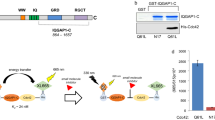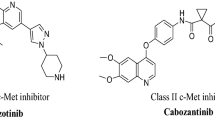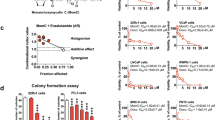Abstract
ROCK1 and ROCK2 mediate important processes such as cell migration, invasion and metastasis, making them good targets for the development of antitumor agents. Recently, using a fragment-based approach and X-ray crystallography, we reported on the design and synthesis of novel Rho-kinase inhibitors (RKIs). Here, we selected a pair of RKIs, the closely related structural analogs RKI-18 (potent; IC50 values of 397 nM (ROCK1) and 349 nM (ROCK2)) and RKI-11 (weak/inactive; IC50 values of 38 μM (ROCK1) and 45 μM (ROCK2)), as chemical probes and determined their effects on cytoskeleton organization, signaling, apoptosis, anchorage-dependent and independent growth, migration and invasion. RKI-18 but not RKI-11 suppresses potently the phosphorylation of the ROCK substrate myosin light chain 2 (MLC2) in intact human breast, lung, colon and prostate cancer cells. Furthermore, RKI-18 is highly selective at decreasing the levels of P-MLC2 over those of P-Akt, P-S6 and P-Erk ½. RKI-18 suppresses ROCK-mediated actin fiber formation, following stimulation with LPA as well as p21-activated kinase (PAK)-mediated lamellipodia and filopodia formation following bradykinin or PDGF stimulation. Furthermore, RKI-18 but not RKI-11 inhibits migration, invasion and anchorage-independent growth of human breast cancer cells. The fact that the active ROCK inhibitor RKI-18, but not the inactive closely related structural analog RKI-11 is effective at suppressing malignant transformation suggests that inhibition of ROCK with RKI-18 results in preventing migration, invasion and anchorage-independent growth. The potential of this class of RKIs as anti-tumor agents warrants further advanced preclinical studies.
This is a preview of subscription content, access via your institution
Access options
Subscribe to this journal
Receive 50 print issues and online access
$259.00 per year
only $5.18 per issue
Buy this article
- Purchase on Springer Link
- Instant access to full article PDF
Prices may be subject to local taxes which are calculated during checkout





Similar content being viewed by others
References
Amano M, Fukata Y, Kaibuchi K . Regulation and functions of Rho-associated kinase. Exp Cell Res 2000; 261: 44–51.
Somlyo AP, Somlyo AV . Ca2+ sensitivity of smooth muscle and nonmuscle myosin II: modulated by G proteins, kinases, and myosin phosphatase. Physiol Rev 2003; 83: 1325–1358.
Zicha D, Dobbie IM, Holt MR, Monypenny J, Soong DY, Gray C et al. Rapid actin transport during cell protrusion. Science 2003; 300: 142–145.
Redowicz MJ . Rho-associated kinase: involvement in the cytoskeleton regulation. Arch Biochem Biophys 1999; 364: 122–124.
Tang Y, Olufemi L, Wang MT, Nie D . Role of Rho GTPases in breast cancer. Front Biosci 2008; 13: 759–776.
Riento K, Ridley AJ . Rocks: multifunctional kinases in cell behaviour. Nat Rev Mol Cell Biol 2003; 4: 446–456.
Olson MF . Applications for ROCK kinase inhibition. Curr Opin Cell Biol 2008; 20: 242–248.
Olson MF, Sahai E . The actin cytoskeleton in cancer cell motility. Clin Exp Metastasis 2009; 26: 273–287.
Scott RW, Olson MF . LIM kinases: function, regulation and association with human disease. J Mol Med (Berl) 2007; 85: 555–568.
Liu S, Goldstein RH, Scepansky EM, Rosenblatt M . Inhibition of rho-associated kinase signaling prevents breast cancer metastasis to human bone. Cancer Res 2009; 69: 8742–8751.
Lane J, Martin TA, Watkins G, Mansel RE, Jiang WG . The expression and prognostic value of ROCK I and ROCK II and their role in human breast cancer. Int J Oncol 2008; 33: 585–593.
Routhier A, Astuccio M, Lahey D, Monfredo N, Johnson A, Callahan W et al. Pharmacological inhibition of Rho-kinase signaling with Y-27632 blocks melanoma tumor growth. Oncol Rep 2010; 23: 861–867.
Ying H, Biroc SL, Li WW, Alicke B, Xuan JA, Pagila R et al. The Rho kinase inhibitor fasudil inhibits tumor progression in human and rat tumor models. Mol Cancer Ther 2006; 5: 2158–2164.
Itoh K, Yoshioka K, Akedo H, Uehata M, Ishizaki T, Narumiya S . An essential part for Rho-associated kinase in the transcellular invasion of tumor cells. Nat Med 1999; 5: 221–225.
Imamura F, Mukai M, Ayaki M, Akedo H . Y-27632, an inhibitor of rho-associated protein kinase, suppresses tumor cell invasion via regulation of focal adhesion and focal adhesion kinase. Jpn J Cancer Res 2000; 91: 811–816.
Wyckoff JB, Pinner SE, Gschmeissner S, Condeelis JS, Sahai E . ROCK- and myosin-dependent matrix deformation enables protease-independent tumor-cell invasion in vivo. Curr Biol 2006; 16: 1515–1523.
Yoshioka K, Foletta V, Bernard O, Itoh K . A role for LIM kinase in cancer invasion. Proc Natl Acad Sci USA 2003; 100: 7247–7252.
Bourguignon LY, Zhu H, Shao L, Zhu D, Chen YW . Rho-kinase (ROK) promotes CD44v(3,8–10)-ankyrin interaction and tumor cell migration in metastatic breast cancer cells. Cell Motil Cytoskeleton 1999; 43: 269–287.
Li B, Zhao WD, Tan ZM, Fang WG, Zhu L, Chen YH . Involvement of Rho/ROCK signalling in small cell lung cancer migration through human brain microvascular endothelial cells. FEBS Lett 2006; 580: 4252–4260.
Yoshioka K, Nakamori S, Itoh K . Overexpression of small GTP-binding protein RhoA promotes invasion of tumor cells. Cancer Res 1999; 59: 2004–2010.
Clark EA, Golub TR, Lander ES, Hynes RO . Genomic analysis of metastasis reveals an essential role for RhoC. Nature 2000; 406: 532–535.
Ridley AJ . Rho proteins and cancer. Breast Cancer Res Treat 2004; 84: 13–19.
Sahai E, Marshall CJ . RHO-GTPases and cancer. Nat Rev Cancer 2002; 2: 133–142.
Fritz G, Just I, Kaina B . Rho GTPases are over-expressed in human tumors. Int J Cancer 1999; 81: 682–687.
Burbelo P, Wellstein A, Pestell RG . Altered Rho GTPase signaling pathways in breast cancer cells. Breast Cancer Res Treat 2004; 84: 43–48.
Suwa H, Ohshio G, Imamura T, Watanabe G, Arii S, Imamura M et al. Overexpression of the rhoC gene correlates with progression of ductal adenocarcinoma of the pancreas. Br J Cancer 1998; 77: 147–152.
Kleer CG, van Golen KL, Zhang Y, Wu ZF, Rubin MA, Merajver SD . Characterization of RhoC expression in benign and malignant breast disease: a potential new marker for small breast carcinomas with metastatic ability. Am J Pathol 2002; 160: 579–584.
Li R, Martin MP, Liu Y, Wang B, Patel RA, Zhu JY et al. Fragment-based and structure-guided discovery and optimization of Rho kinase inhibitors. J Med Chem 2012; 55: 2474–2478.
Slack-Davis JK, Eblen ST, Zecevic M, Boerner SA, Tarcsafalvi A, Diaz HB et al. PAK1 phosphorylation of MEK1 regulates fibronectin-stimulated MAPK activation. J Cell Biol 2003; 162: 281–291.
Bishop AL, Hall A . Rho GTPases and their effector proteins. Biochem J 2000; 348: 241–255.
Patel RA, Forinash KD, Pireddu R, Sun Y, Sun N, Martin MP et al. RKI-1447 is a potent inhibitor of the Rho-associated ROCK kinases with anti-invasive and anti-tumor activities in breast cancer. Cancer Res 2012; 72: 5025–5034.
Vigil D, Kim TY, Plachco A, Garton AJ, Castaldo L, Pachter JA et al. ROCK1 and ROCK2 are required for non-small cell lung cancer anchorage-independent growth and invasion. Cancer Res 2012; 72: 5338–5347.
Balasis ME, Forinash KD, Chen YA, Fulp WJ, Coppola D, Hamilton AD et al. Combination of farnesyltransferase and Akt inhibitors is synergistic in breast cancer cells and causes significant breast tumor regression in ErbB2 transgenic mice. Clin Cancer Res 2011; 17: 2852–2862.
Acknowledgements
We would like to thank Nan Sun (Moffitt Cancer Center) and the following Moffitt Cancer Center core facilities: the Chemical Biology Core, the Analytical Microscopy Core and Comparative Medicine Core facility. This work was supported by NCI grant U19 CA 067771.
Author information
Authors and Affiliations
Corresponding author
Ethics declarations
Competing interests
The authors declare no conflict of interest.
Rights and permissions
About this article
Cite this article
Patel, R., Liu, Y., Wang, B. et al. Identification of novel ROCK inhibitors with anti-migratory and anti-invasive activities. Oncogene 33, 550–555 (2014). https://doi.org/10.1038/onc.2012.634
Received:
Revised:
Accepted:
Published:
Issue Date:
DOI: https://doi.org/10.1038/onc.2012.634
Keywords
This article is cited by
-
ROCK1/2 signaling contributes to corticosteroid-refractory acute graft-versus-host disease
Nature Communications (2024)
-
Circ_0064288 acts as an oncogene of hepatocellular carcinoma cells by inhibiting miR-335-5p expression and promoting ROCK1 expression
BMC Cancer (2022)
-
RETRACTED ARTICLE: Overexpression of ROCK1 promotes cancer cell proliferation and is associated with poor prognosis in human urothelial bladder cancer
Mammalian Genome (2021)
-
Targeting the cytoskeleton against metastatic dissemination
Cancer and Metastasis Reviews (2021)
-
Design of novel ROCK inhibitors using fragment-based de novo drug design approach
Journal of Molecular Modeling (2020)



